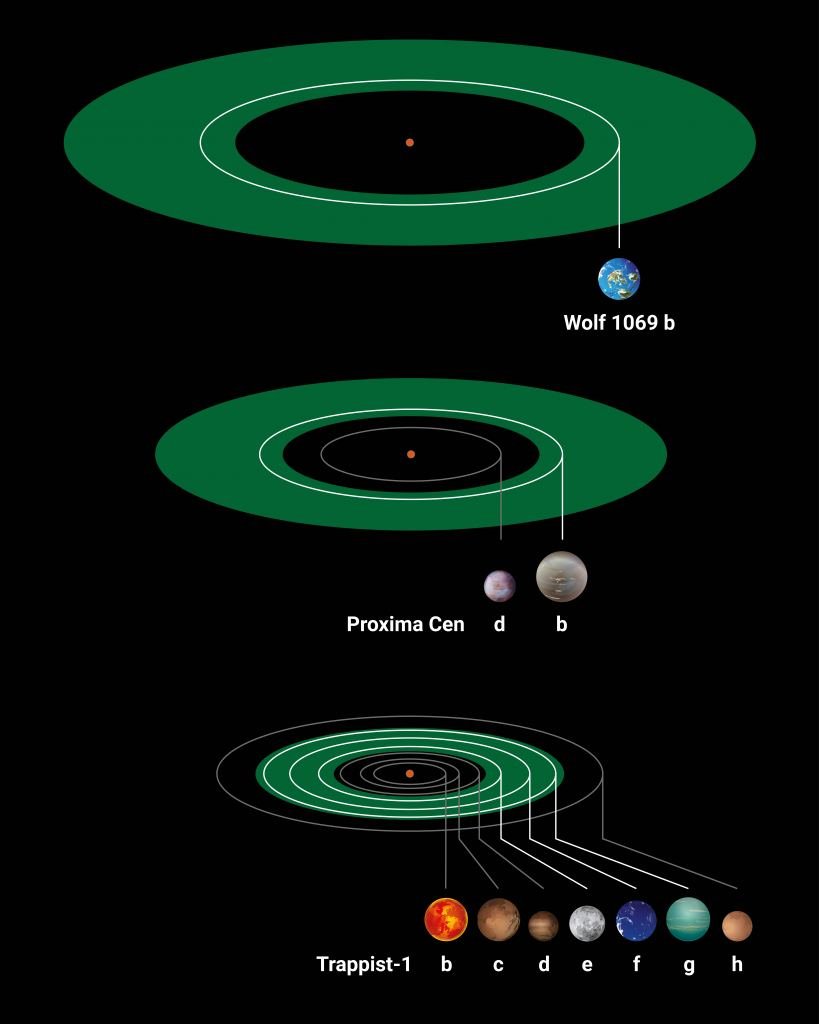Researchers from the Max Planck Institute for Astronomy (MPIA) say they have spotted a potentially habitable exoplanet hanging out in our cosmic backyard. The researchers also note that the planet, which was found only 31 light years away from Earth orbiting the star Wolf 1069, is both earth-sized and orbits a relatively low radiation red dwarf star, dramatically increasing the chances it could support extraterrestrial life.
Potentially Habitable Exoplanet LIST Keeps Growing
Since the discovery of the first planet outside of our solar system in 1995, the list of planets confirmed by astronomers has continued to grow. A number of these space bodies are gas giants like Jupiter or Saturn since a larger planet is much easier to spot than one that is earth-sized one. Unfortunately, at least based on what we know, gas giants would be unlikely to support the type of life found here on Earth. (Note: some of these larger gas giants may have moons that are potentially habitable, but spotting them is something we currently don’t have the tools to do)
Fortunately for astronomers, our observatories, telescopes, and software analysis tools have become sophisticated enough to spot earth-sized planets given the right conditions. In most cases (thus far) the key to spotting earth-sized rocky worlds has been the nature of their host stars.
Specifically, many of these potential “second-earths” have been found orbiting red dwarf stars. That’s because red dwarf stars are much cooler and smaller than main sequence stars like our sun, so when exoplanets pass in front of their host star, our observatories can detect enough dimming to determine if a planet is present, as well as its likely composition, orbit, and size. The smaller stars also mean that astronomers can more easily detect the gravitational effects planets have on their hosts, which is the other way we typically find exoplanets.
This latest discovery is just such a planet, and it has astronomers even more excited than usual due to its size, type, and proximity to Earth, as well as its potential for harboring extraterrestrial life.
Wolf 1069 Exoplanet in a Life-Friendly Orbit and Low Radiation Zone
The latest find, which is part of the Max Plank Institute’s CARMENES program (short for Calar Alto high-Resolution search for M dwarfs with Exoearths with Near-infrared and optical Echelle Spectrographs) has a number of things going for it that make it a perfect place to look for life.
First, as noted, Wolf 1069 b (the planet’s name) is nearly the same size as Earth. This is important, as less than a hundred of the 5,200 exoplanets spotted to date are smaller than the size of two Earths. For a number of physics, chemistry, and biology reasons, planets that are significantly larger (or dramatically smaller) than Earth would have a hard time supporting life as we know it. Of course, life in the cosmos may be stranger than we think and these sorts of things may not affect habitability, but since we only have one example of a planet with life on it, the best use of the limited resources allocated to search for E.T. is looking for places where the type of life we have on Earth could survive.
The second thing the newly-discovered exoplanet has going for it is the low radiation zone it calls home. Astrobiologists often point out that even if an exoplanet is in the habitable zone (the orbit where liquid water could exist on its surface), the greatly reduced temperature of a red dwarf compared to stars like our sun means that the habitable zone is much closer to the star.
In the case of the newly discovered Wolf 1069 b, “the so-called habitable zone is shifted inwards,” says lead author Diana Kossakowski, in a press release announcing the find. Normally this would mean it is much closer to the source of extreme radiation that could strip the planet of its atmosphere. Again, in our limited understanding of habitability, no atmosphere equals no life. But surprisingly, the researchers behind this latest discovery have found that the host star is extremely calm, emitting very little life-killing radiation.
“Despite the close range, Wolf 1069 b only receives about 65% of the incident radiant power of what the Earth obtains from the Sun,” explains the same press release. “Compared to solar properties, Wolf 1069 emits much less radiation, and its surface is cooler, making the star appear orange.”
This dramatic reduction in radiation means that the newly discovered exoplanet may be able to keep any atmosphere it may have. Again, an atmosphere dramatically increases the chances for life as we know it.
The one potentially mitigating factor in the hunt for life around red dwarf stars is the fact that planets this close to their host stars are often tidally locked, meaning that one side is always facing the star and the other is always facing space. Wolf 1069 b is no exception. Still, the researchers behind this latest find say they think a significant portion of the ‘daylight side” of the planet is potentially habitable, so being tidally locked may not be a significant issue in this particular case.


CARMENES Perfectly Suited to Hunt for Potentially Habitable Exoplanets
Although most exoplanets have been spotted using space observatories like the Kepler Space Telescope or the Transiting Exoplanet Survey Satellite (TESS), the researchers behind this latest find say that their system is likely to continue to produce tantalizing targets in the search for extraterrestrial life.
“The CARMENES instrument was built for the very purpose of making it easier to discover as many potentially habitable worlds as possible,” explains study co-author Jonas Kemmer from Heidelberg University.
“Our computer simulations show that about 5% of all evolving planetary systems around low-mass stars, such as Wolf 1069, end up with a single detectable planet,” adds MPIA scientist Remo Burn, a team member of the study, meaning they have a huge number of places to look.
One significant benefit to CARMENES is the fact that it uses the radial velocity (RV) method to search for exoplanets. To date, the majority of exoplanets have been found using the transit method, which, as mentioned, looks for a dip in the light emitted by a host star when a planet or planets pass between the star and Earth. But this method is limited because not all exoplanets have orbits that will allow us to spot them this way. The RV method, on the other hand, measures the gravitational effects of a planet or planets on their host star, so even if they don’t pass in front of their host, we can still find them.
Confirming Life on New Exoplanet Likely Still a Decade Away
Wolf 1069 b is the sixth-closest earthlike exoplanet discovered to date, (the closest is Proxima Centauri b, which is just over 4 light years away orbiting the closest star to us) making it a perfect target to search for signs of life. Still, the researchers behind the discovery say we are probably a decade or so away from being able to train our instruments on the planet and search its atmosphere for signs of life.
“We’ll probably have to wait another ten years for this,” said Kossakowski.
The researchers note that the help they need may come in the form of The Extremely Large Telescope (ELT), a ground-based observatory that is currently under construction in Chile. But, they also add, until then, they plan to keep searching for habitable zone exoplanets, growing the list of places future astronomers will search for signs of extraterrestrial life.
“It’s crucial we develop our facilities considering most of the closest potentially habitable worlds are detected via the RV method only,” said Kossakowski.
Christopher Plain is a novelist, comedian, and Head Science Writer at The Debrief. Follow and connect with him on Twitter, learn about his books at plainfiction.com, or email him directly at christopher@thedebrief.org.

